Connecting STEM with Current Events: Making an Impact (Crater)
From Rick McMaster
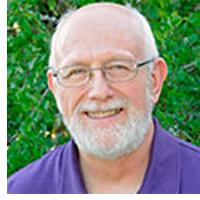 It’s an exciting time for space exploration. Juno is in orbit around Jupiter and the public is being asked which way to point its cameras. LIGO’s detectors have now measured the effects of gravitational waves “from two black holes in their final orbits and then their coalescence into a single black hole” several times. We even have news from JPL, “The recently passed federal budget for fiscal year 2016 includes $50 million for NEO [Near Earth Objects] observations and planetary defense, representing a more than ten-fold increase since the beginning of the current administration.” It’s an exciting time for space exploration. Juno is in orbit around Jupiter and the public is being asked which way to point its cameras. LIGO’s detectors have now measured the effects of gravitational waves “from two black holes in their final orbits and then their coalescence into a single black hole” several times. We even have news from JPL, “The recently passed federal budget for fiscal year 2016 includes $50 million for NEO [Near Earth Objects] observations and planetary defense, representing a more than ten-fold increase since the beginning of the current administration.”
With space in the headlines, what better time to connect STEM with current events than through a back-to-school activity like Impact Craters. I have adapted NASA’s version of this activity to use with upper elementary and middle school students in a 45 minute period.
I start with asking the differences among meteoroids, meteors, and meteorites and then move on to why our moon has so many  impact craters and the earth relatively so few. This fits into the earth science curriculum when I add discussions of wind and water erosion, earthquakes and volcanoes. impact craters and the earth relatively so few. This fits into the earth science curriculum when I add discussions of wind and water erosion, earthquakes and volcanoes.
There is a bit of prep needed for this activity. Each student table needs a large baking tray 2/3s full of sifted flour (Be sure to ask the educators in advance if anyone has a gluten allergy. If this is a problem cornstarch or sand can be substituted or the student(s) may be excused.), a ruler (in centimeters), a 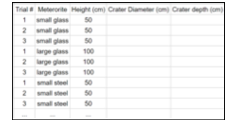 meter stick (hollow ones, if available, allow the angle of impact to be varied), tweezers, and a tablet (optional) for recording data and videoing the impacts. The instructor’s table holds a large canister of Nesquik (an inexpensive way to provide the contrast) and a selection of meteors/meteorites including two sizes of glass marbles and a number of sizes of steel ball bearings. (In contrast, you can add less dense plastic spheres.) The densities of the glass marbles and steel ball bearings are calculated in advance and shared with the class. meter stick (hollow ones, if available, allow the angle of impact to be varied), tweezers, and a tablet (optional) for recording data and videoing the impacts. The instructor’s table holds a large canister of Nesquik (an inexpensive way to provide the contrast) and a selection of meteors/meteorites including two sizes of glass marbles and a number of sizes of steel ball bearings. (In contrast, you can add less dense plastic spheres.) The densities of the glass marbles and steel ball bearings are calculated in advance and shared with the class.
 A review of the materials leads naturally to a discussion of independent and dependent variables. Together we develop the general experimental design but details are left to the individual student teams. An example of one team’s experimental design is shown at the left. They should decide at the start what determines both the crater diameter and depth and how best to measure each. Depending on how much time is available, the students can limit or expand the data taken. A review of the materials leads naturally to a discussion of independent and dependent variables. Together we develop the general experimental design but details are left to the individual student teams. An example of one team’s experimental design is shown at the left. They should decide at the start what determines both the crater diameter and depth and how best to measure each. Depending on how much time is available, the students can limit or expand the data taken.
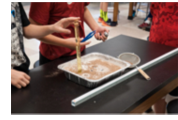 As the students are deciding how to proceed, sift the Nesquik on the top surface of the flour. Now the excitement begins. Many of the students end up covered with flour but enjoy this hands-on experiment so much that they view it as a mark of distinction. “Science can be messy!” As the students are deciding how to proceed, sift the Nesquik on the top surface of the flour. Now the excitement begins. Many of the students end up covered with flour but enjoy this hands-on experiment so much that they view it as a mark of distinction. “Science can be messy!”
Plan to leave time at the end of the class for each team to briefly describe their results, the conclusions they have drawn, and to share a video of an impact. If the tablet or smart phone has slow motion recording, the video can be very impressive.
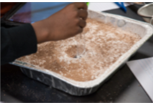 Conclude the activity by talking about how the experiment and data collection could be improved and what other independent variables could be introduced if there were more time and materials available. Perhaps you will see some of these follow-ups in future science projects. Conclude the activity by talking about how the experiment and data collection could be improved and what other independent variables could be introduced if there were more time and materials available. Perhaps you will see some of these follow-ups in future science projects.
One teacher produced this video of her classes. My thanks to her for allowing me to share it.
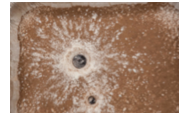 I continue to learn about being an informal educator in the classroom. Technology failed me during one Impact Craters lab. I didn’t have my slides available so I just sat on the edge of the front table, and we discussed what we were going to do that day. The teachers commented that the students were much more engaged. We were all working together on the activity. Now I avoid even a few slides - short videos are okay if they are relevant and exciting. I may write a few critical things on the boards but the focus is the conversation about science, math, and engineering and how it relates to the world around us all. I continue to learn about being an informal educator in the classroom. Technology failed me during one Impact Craters lab. I didn’t have my slides available so I just sat on the edge of the front table, and we discussed what we were going to do that day. The teachers commented that the students were much more engaged. We were all working together on the activity. Now I avoid even a few slides - short videos are okay if they are relevant and exciting. I may write a few critical things on the boards but the focus is the conversation about science, math, and engineering and how it relates to the world around us all.
Rick McMaster retired from IBM as the STEM Advocate in December 2013, but continues his work in “STEM and more” through occasional tweets and blogging, continuing to serve on various technical boards, and chairing the Central Texas Discover Engineering outreach. You can reach him at drrhmcm@gmail.com, for continuing discussion.
Back to newsletter |